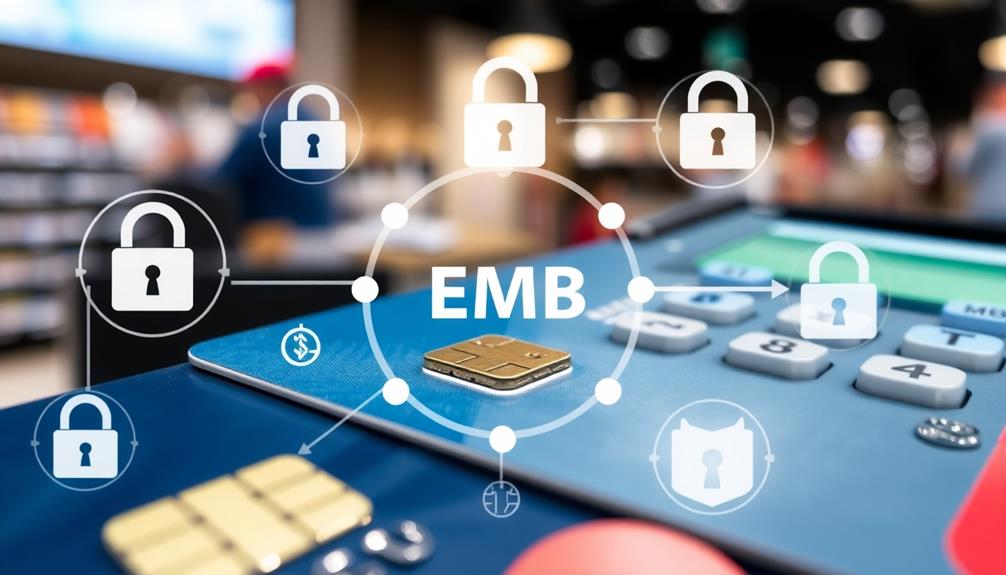The chargeback liability shift for EMV makes merchants responsible if they haven’t upgraded to chip card technology. When a transaction occurs, if the merchant uses a non-EMV terminal, they may be liable for fraudulent charges, shifting the financial risk from issuers. To avoid this, merchants must implement EMV-compatible systems, which considerably reduce their liability. Staying compliant can improve security and reduce losses; learn about how this shift works and your options if you continue exploring this topic.
Key Takeaways
- The liability shift assigns responsibility for fraudulent charges to the party with outdated or non-EMV compliant equipment.
- Merchants who haven’t upgraded to EMV technology may be liable for chargebacks caused by card-present fraud.
- When both merchant and issuer are EMV-compliant, liability typically remains with the issuer in case of fraud.
- Proper implementation of EMV chip reader systems helps merchants avoid liability for fraudulent in-person transactions.
- The shift incentivizes merchants to adopt secure, EMV-compatible point-of-sale systems to reduce chargeback risks.

Have you ever wondered who’s responsible when a disputed transaction occurs? It’s a common question, especially with the shift toward EMV chip technology and the increasing complexity of fraud prevention strategies. When you make a purchase with your card in person at a store, that’s considered a card present transaction. This type of transaction typically offers better security because the chip in your card generates a unique transaction code, making it much harder for criminals to duplicate or misuse. As a result, merchants and card issuers have clearer roles in managing fraud and liability.
With EMV technology, the liability shift means responsibility for certain fraud losses moves depending on whether the merchant has implemented chip card readers and follows the latest standards. Prior to EMV adoption, if a fraudulent transaction occurred with a chip card, the issuer often bore the blame. Now, if a merchant hasn’t upgraded to EMV chip terminals, and a fraud occurs during a card present transaction, the merchant could be held liable. This shift incentivizes merchants to adopt EMV-compliant devices to minimize their exposure to fraud-related charges.
Fraud prevention strategies become vital in this regard. Merchants need to verify that their point-of-sale systems are up-to-date and capable of processing chip-enabled cards. This not only reduces their liability but also protects customers’ sensitive information. For example, incorporating advanced security features like PIN verification, contactless verification, and monitoring for suspicious activity can further enhance protection. For consumers, it’s important to understand that EMV cards are designed to make fraud more difficult, but they don’t eliminate all risks. That’s why many merchants also implement additional security measures like PIN verification, contactless verification, and monitoring for suspicious activity.
In essence, the responsibility for handling disputes shifts based on the transaction type and the merchant’s compliance with EMV standards. When a transaction occurs, and a dispute arises, the issuer and merchant work together to determine liability. If the merchant has the right equipment and follows recommended fraud prevention strategies, they usually avoid being held liable for counterfeit or stolen card fraud. Conversely, if they neglect to upgrade or ignore security protocols, they could face financial penalties.
This liability shift helps to promote better security practices across the board. It encourages merchants to invest in secure payment infrastructure, which benefits everyone by reducing fraud and protecting sensitive data. As a customer, understanding this shift can help you appreciate the importance of using EMV chip cards and the role of fraud prevention strategies in safeguarding your transactions. Ultimately, it’s a collaborative effort aimed at making in-person transactions safer and more secure for all parties involved.
Frequently Asked Questions
How Does EMV Technology Prevent Fraud Beyond Chargebacks?
EMV technology prevents fraud by making transactions more secure than magnetic stripe cards. When you use an EMV chip, it generates a unique transaction code, making it nearly impossible for criminals to clone your card. Unlike magnetic stripe transactions, EMV reduces reliance on signature capture, which is less secure. This dynamic process helps protect you from card-present fraud, keeping your account safer beyond just minimizing chargebacks.
What Are the Costs Associated With Implementing EMV Chip Card Systems?
Thinking of embracing EMV chip cards? Well, brace yourself for some cost considerations! You’ll need to budget for infrastructure upgrades—new terminals, software updates, and staff training. Not cheap, but hey, it’s an investment in security. The initial costs might make your wallet cry, but in the long run, you’ll reduce fraud and save money—so, think of it as a small price for peace of mind.
How Do Cardholder Disputes Impact Liability Shift Timing?
When a cardholder dispute occurs, it can affect the liability shift timing, especially if the dispute leads to a chargeback. Quick dispute resolution helps prevent fraud and minimizes liability, ensuring you meet EMV compliance deadlines. By actively addressing issues, you strengthen fraud prevention and reduce the risk of being held liable for fraudulent transactions. Prompt handling of disputes keeps your business protected and aligns with the EMV liability shift process.
Are There Specific Industries More Affected by Liability Shifts?
Imagine retail security as your fortress against fraud—some industries, like hospitality and e-commerce, face more attack waves from fraudsters. These sectors are hit harder by liability shifts because they often lack robust fraud prevention techniques. If you don’t upgrade your systems, you risk losing big to chargebacks. Staying ahead means investing in advanced fraud prevention techniques and EMV chip technology to protect your business and customers effectively.
How Do International EMV Standards Differ From U.S. Implementations?
International standards for EMV emphasize global interoperability, guaranteeing cards work seamlessly worldwide, while U.S. implementations often include unique features like EMV chip-and-signature or chip-and-PIN options. You’ll notice differences in security protocols, transaction processing, and acceptance infrastructure. These implementation differences mean your card might behave slightly differently abroad, but understanding international standards helps you navigate these variations smoothly and guarantees your payments remain secure, wherever you travel.
Conclusion
As you step into a world where transactions shimmer with encrypted certainty, the liability shift becomes your shield and sword. Picture a digital fortress safeguarding your customers’ trust, with EMV chip technology illuminating the path forward. By understanding this shift, you hold the power to navigate the complex landscape of payments confidently. Embrace the change, and let your business stand resilient amidst the evolving tide of fraud and liability, shining brighter with each secure transaction.










